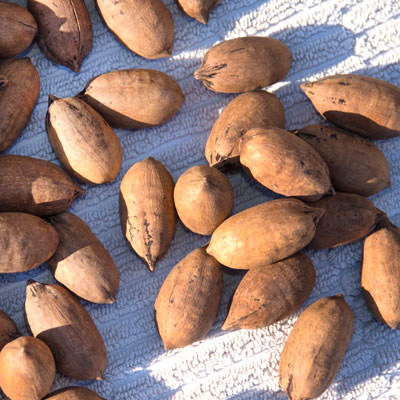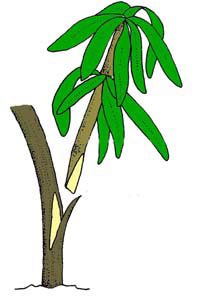Question of the Week: January 10, 2019
“I’d like to grow oaks and pecans from seed. How do I do it?”
If you plant either of these trees from seeds you’re going to get oak and pecan trees back. But will they be exactly the same? Let’s examine each individually.

Pecans…
As anyone who suffers from allergies when pecans are in full bloom (as I do) knows, wind carries pecan pollen for many miles. That means that when you hold a pecan in your hand, you know what the mother’s fruit looked like (because that’s the pecan you’re holding), but you have no idea what the pecans from the pollen source (father tree) looked like. They may be gnarly, hard-shelled little things with almost no flavor. And the trees themselves could be insect- and disease-prone, unfit for use in Texas home orchards.
Put in shorter terms, pecans, like peaches, plums and other fruit trees, do not “come true” from seeds. If you want a high-quality pecan tree, you need to buy a grafted tree of a variety recommended for your part of Texas.

Graphics borrowed from Texas A&M Dept. of Horticulture.
Grafting, as in the simple illustration above, ensures you get quality fruit of a known variety for all your space, time and effort. There are many pieces of instructional information on the TAMU aggie-horticulture website concerning fruit and pecan grafting.
Oaks…
Botanists will tell you that oaks are also nut-producing trees, and they, too, are pollinated by wind. However, almost all oaks that you buy in nurseries are grown from acorns anyway, so you certainly can plant your own.
Collect them as soon as you can after they hit the ground. Nothing good happens to acorns after they’re down. They either get eaten by squirrels or birds (or around our rural neighborhood, by feral hogs), or insect larvae devour their embryos. If they’re on the ground long enough, the embryos dry out and die.
Three quick tests to determine if an acorn is good…
1. Look for any tiny holes that would suggest larvae have emerged from them. If you see a hole, that acorn is probably no good.
2. Shake them. If an acorn rattles, it has probably dried out.
3. Put them in a bucket of water. Any that float will be no good.
I prefer to plant acorns in 1-gallon pots filled with a really good potting soil.
I push them into the soil with the pointed ends down (by pressing against the cap ends). This isn’t critical, however. They’ll germinate from any direction.
Plant them at depths equal to their lengths, one acorn per pot. Firm the soil around them and water them thoroughly.
I’m in North Central Texas, so I snug the pots together and draw plastic or wood up around the edge of the group to stop the north wind. That’s less important in South Texas. I keep them moist at all times all winter.
When the seedlings are about 1 foot tall I repot them into larger containers. I loosen any encircling roots at the bottoms of the pots in the process.
